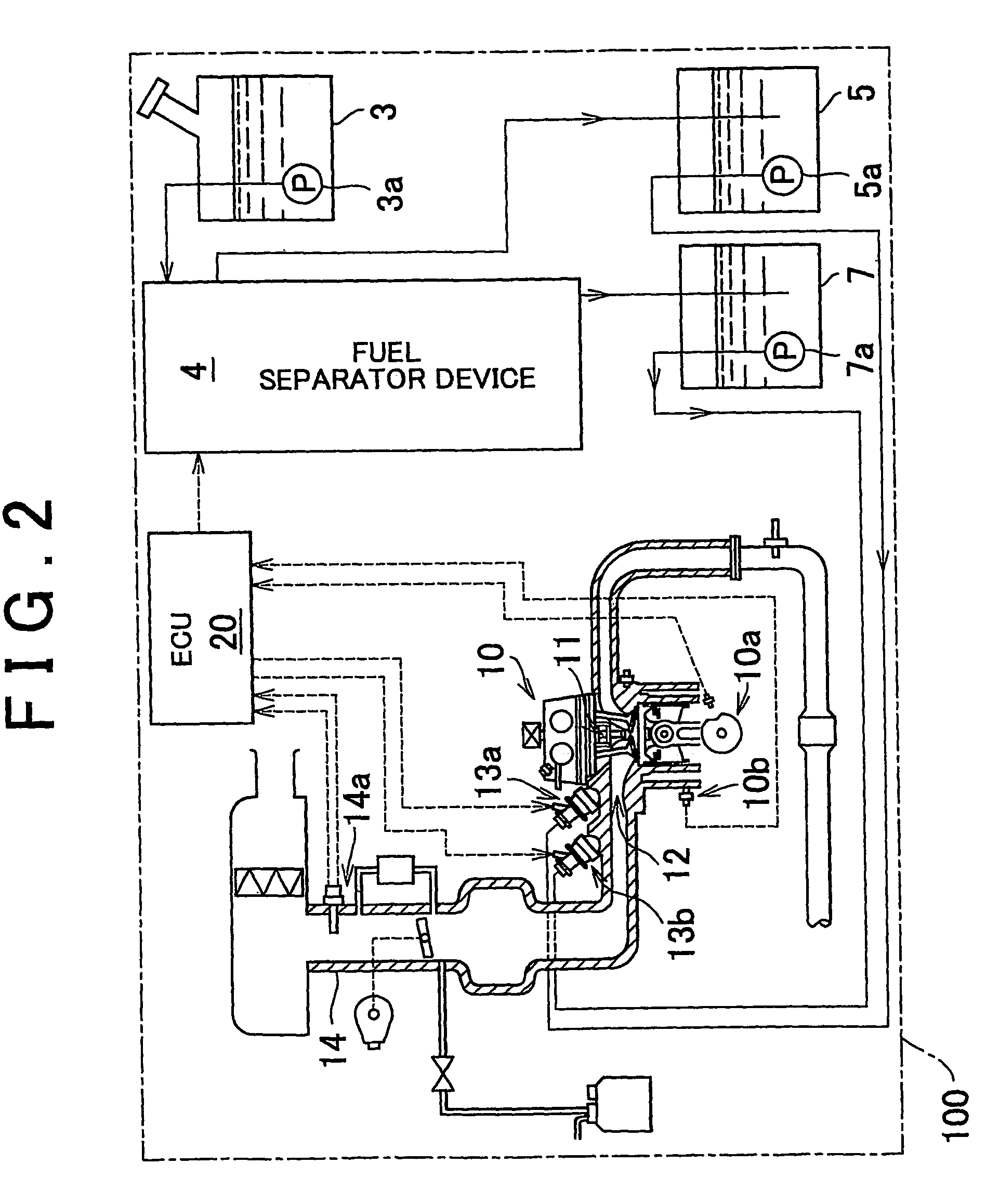Spark ignition internal combustion engine
a technology of internal combustion engine and spark ignition, which is applied in the direction of machines/engines, electric control, instruments, etc., can solve the problems of poor ignitability of low-octane fuels, poor antiknock properties, poor ignitability of high-octane fuels, etc., and achieve good prediction of mixing proportions. , the effect of good prediction
- Summary
- Abstract
- Description
- Claims
- Application Information
AI Technical Summary
Benefits of technology
Problems solved by technology
Method used
Image
Examples
first embodiment
[0042]Preferred embodiments of the invention will be described hereinafter with reference to the accompanying drawings. FIG. 1 is a schematic diagram illustrating a construction of a Referring to FIG. 1, a low-octane fuel tank 5 of a vehicle 100 stores a low-octane fuel that has a relatively low octane number, and a high-octane fuel tank 7 stores a high-octane fuel that has a relatively high octane number.
[0043]The low-octane fuel and the high-octane fuel are supplied to fuel injection valves 13a, 13b via a low-octane fuel pump 5a and a high-octane fuel pump 7a, respectively. The two fuel injection valves 13a, 13b are attached to an intake port 12 of a spark ignition internal combustion engine (hereinafter, simply referred to as “engine”) that has an ignition plug 11. The fuel injection valves 13a, 13b inject into the intake port 12 the low-octane fuel and the high-octane fuel at predetermined proportions suitable for the operating condition in accordance with a command from an ele...
second embodiment
[0059]A second embodiment will next be described.
[0060]FIG. 4 is a flowchart illustrating a control of a second embodiment as a first modification of the first embodiment. Steps 101 to 112 are the same as those in the first embodiment. The second embodiment is different from the first embodiment in that step 113 is added, in which the retardation in timing caused by the knock control is removed.
[0061]FIG. 18 illustrates concept and effect of a control of the second embodiment. As indicated in FIG. 18, if knocking occurs, the ignition timing is retarded by the knock control. However, the high-octane fuel proportion RHRON is increased, so that occurrence of knocking becomes unlikely and therefore the ignition timing is returned to the original timing. Hence, the fuel consumption reduces (the fuel efficiency improves), and deterioration in fuel economy can be prevented.
[0062]A third embodiment will next be described. FIG. 5 is a flowchart illustrating a control in accordance with the t...
third embodiment
[0064]FIG. 19 illustrates concept and effect of the control of the As indicated in FIG. 19, if knocking does not occur, the ignition timing is advanced to MBT, so that the fuel consumption reduces (the fuel efficiency improves) and the fuel economy improves. If the basic ignition timing SA is set at the MBT, there is no effect achieved. However, if the basic ignition timing SA is set at a retarded side of the MBT in order to prevent occurrence of knocking, the ignition timing can be advanced to the MBT. Therefore, the aforementioned effect can be achieved.
[0065]Next, a fourth embodiment will be described. FIG. 6 is a flowchart illustrating a control in accordance with the fourth embodiment. Steps 101 to 113 are the same as those in the second embodiment. However, the fourth embodiment is different from the second embodiment in that step 114a is added. In step 114a, the low-octane fuel proportion is increased if a negative determination is made in step 102, that is, if knocking does...
PUM
 Login to View More
Login to View More Abstract
Description
Claims
Application Information
 Login to View More
Login to View More - R&D
- Intellectual Property
- Life Sciences
- Materials
- Tech Scout
- Unparalleled Data Quality
- Higher Quality Content
- 60% Fewer Hallucinations
Browse by: Latest US Patents, China's latest patents, Technical Efficacy Thesaurus, Application Domain, Technology Topic, Popular Technical Reports.
© 2025 PatSnap. All rights reserved.Legal|Privacy policy|Modern Slavery Act Transparency Statement|Sitemap|About US| Contact US: help@patsnap.com



